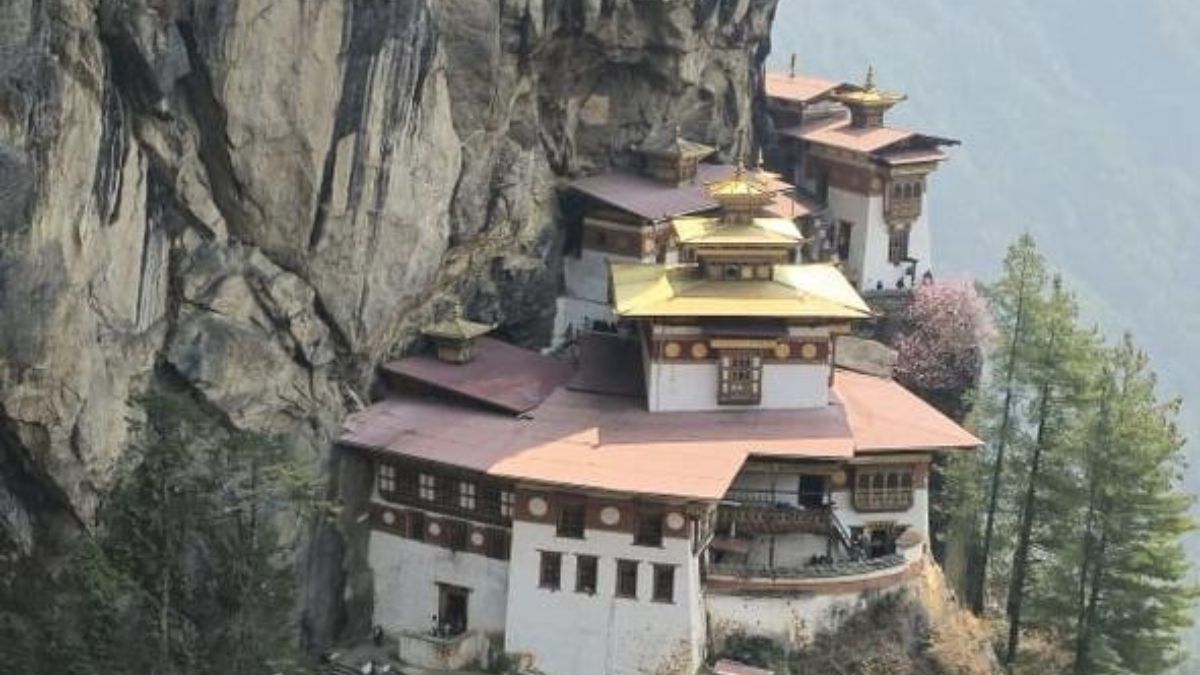Taktsang Monastery: A trek to remember in Bhutan
 Taktsang Monastery in Bhutan | Dr Harsha Haridas
Taktsang Monastery in Bhutan | Dr Harsha Haridas
It was a hot, fried egg-sunny kind of afternoon when we began our trek from the Sang Cheokar Buddhist College in Paro, Bhutan. The first part is a climb through what was once a cool, shady pine forest.
However, the trees got burned down in a forest fire a few years ago, meaning we were walking through silent, scarred sentinels of pines with jagged, blackened branches, fully exposed to the noon elements.
Around an hour into the trek, we were beginning to question our decision to embark on this midday mission when we arrived at a small clearing. There were benches, shaded by prayer flags. A place to rest our weary feet and feast our eyes on the wonderful view of Paro Valley stretched out at our feet. We spent some time there just soaking in the mountains in silence.
The next part of our trek thankfully snaked uphill in the shade of blue pines and rhododendrons. I found pine cones all along the path, some of them symmetrically carved, just waiting to be picked up and turned into a sculpture.
As we climbed higher, I began noticing the piles of stones and objects placed in nooks along the route. Our guide, Karma, told us that these are prayer stones that people place to bring good luck and bless the journey ahead. By this time, we were around 10,000 feet up, and I needed all the luck as my legs were turning to jelly, so I offered up my perfect pine cone and a prayer.
Wild primulas in pink and lavender grow in clusters along the trail, the tiny flowers being the only pops of colour in an otherwise brown-green landscape.
As dusk nears, the cold sets in. Karma begins to get antsy as he says we should be up in the meadows before night falls. The last kilometre before we reach base camp is through an ancient forest. Here we are, intruders in the fabric of time. The sunlight glints through the gnarled, thick tree trunks. All around is the smell of the forest, a mossy, primal scent. Yak dung is evident in many places, and blue-tailed magpies fly among the foliage.
There is a sense that the trees are communicating with each other. Not in words. In a language that we are too young to understand. It is easy to see how Tolkien created Lothlorien in this atmosphere. Electric and serene at the same time. The dry leaves rustle underfoot as the forest gives way to a spectacular meadow where horses graze and yaks breed. We are just in time to see the sun setting over the snowy Himalayas.
The Bumdrak Monastery is divine in the chilly morning air. On one hand, there’s the light-headedness of that altitude; on the other, there’s a spirituality about the place that’s meditative.
We begin our descent in the morning, and the first sight of the golden tops of the Taktsang Monastery takes my breath away. Also known as the Tiger’s Nest Monastery, this sacred Buddhist pilgrimage site is built into the side of a cliff. Looking at it from our vantage point, it’s almost vertiginous—with steps carved into the rock zigzagging through the eight temples that make this shrine dedicated to Guru Padmasambhava.
Legend has it that Guru Rinpoche flew to this location on the back of a tigress and meditated at this location to subdue the evil spirits, hence the name Tigers Nest.
For me, it was the intricate paintings on the walls, the vivid tapestries, the sculptures of Guru Padmasambhava, and the Taras in the temple caves that I still see in my mind’s eye. It is the sense of profound peace I felt surrounded by a thousand golden Buddhas and the exhilaration of physical exertion to reach a destination that you only experience once or twice in a lifetime.
The writer is a psychiatrist in Kannur, Kerala.
Tourism